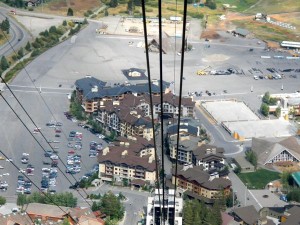Squaw Valley’s proposed development upsets residents
By Kathryn Reed
TAHOE CITY – If the owners of Squaw Valley have their way, the last two buildings from the 1960 Winter Olympics will be demolished and in their place will be infrastructure to make the resort one of the top 10 ski destinations in the world.
This is how Chevis Hosea, vice president of development for Squaw Valley, described the mega-undertaking to the Placer County Planning Commission on Aug. 30 at the Granlibakken conference center.
“We’re not proposing to go up the mountain. We are just asking to develop the base. We will tuck parking under the buildings,” Hosea said. “What is void in this valley is the bed base to support this mountain.”
Hosea said the hotel-condos and fractional ownerships are estimated to bring in $8 million to $10 million a year to county coffers.
However, build-out, assuming the project is permitted, is years away. The first phase is expected to take five years to complete.
While developers know they want the first phase to include several buildings that would encompass 1.3 million-square-feet on 26 acres, a 150,000-square-foot mountain adventure aquatic center, 84,758-square-feet of ski services and 34,187-square-feet for retail and restaurants, the scrutiny has just begun.
The Squaw Valley General Plan and Land Use Ordinance would need to be amended, a program environmental impact report would be done that includes all proposed phases, with project EIRs for each phase that would provide deeper analysis.
During the scoping and environmental analysis phases the public will be asked to comment. The first phase of project review is estimated to take between 18 and 24 months.
About 40 people attended Thursday’s meeting, with 15 people speaking. Most of those who made comments live in the Squaw Valley and are not happy with what the new owners want to do.
KSL Capital Partners bought the resort in November 2010 from Nancy Cushing, who took over sole operation of the resort after her husband died in 2006. Squaw Valley Ski Holdings Inc. was formed last September to operate Squaw and Alpine Meadows.
Much of what is being proposed would surround the existing village that was built by Intrawest nearly 10 years ago.
Carolyn Chambers, who is a homeowner in the valley, said people are forgetting this is a residential neighborhood.
“Let’s stop calling it a village,” she said. “What is proposed here is a commercial development.” She went on to describe a village as something more than shops for tourists and more like what can be found in Europe.
Traffic, parking, potable water and 10- to 12-story buildings are concerns of those who spoke.
The potential maximum height being proposed for buildings in phase one is 163 feet and 189 feet in phase four. As a comparison, the tallest casino in Stateline is 197 feet. And the current Squaw village is four stories on top of a two-level parking garage.
Hosea said there are no height restrictions at Squaw, but his employer would like to put some on the books.
(The Tahoe Regional Planning Agency does not have a say in this project because it is outside the Lake Tahoe Basin.)
Paul Archer in his 50-plus years as a resident at Squaw has seen the “environmental degradation” and worries more is on the horizon.
Mark Simpson said people come to Squaw to ski no matter how hard people try to make it a year-round destination. He doesn’t want Squaw to turn into another Northstar.
“One of the big failures of Northstar is you can’t get to the resort. Then when you get to the village there is not enough capacity to get up on the mountain,” Simpson said of the horrendous parking at Northstar and the ancient gondola.
Hosea told the group an extensive scientific study of the water system will be done which could cost $1 million. He said rebuilding the supply system could cost between $5 million and $10 million.
“There is no value to provide a faux water supply,” Hosea said. He added that is would not be a good business decision to have people staying in one of the two high-end hotels and have a dry spigot.
Parking for the day skiers will be partly on one level of the lodging establishments as well as at a proposed lot that would be built down the road and serviced by a shuttle.
“There is a real opportunity to reposition this asset globally,” Hosea said. That, and making a place to travel to every season is what the owners want to do.
Alex Fisch with the Planning Services Division of Placer County is the lead public official on the project. He may be contacted at Afisch@placer.ca.gov.
